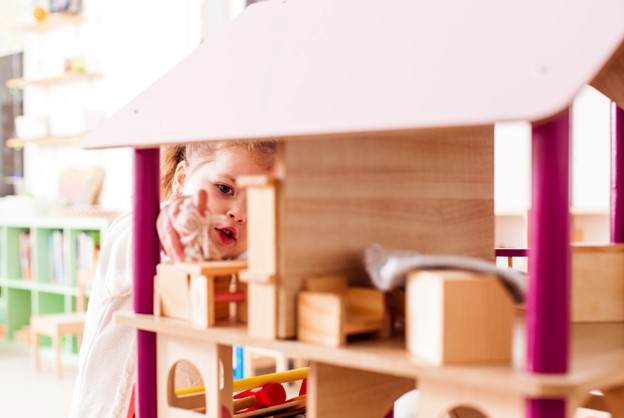How Can a Dollhouse With Furniture Teach Our Children Family’s Values?

Sounds a bit too good to be true: can a simple toy, such a dollhouse with furniture, lay the foundation for a wonderful lesson for our children? Can they really learn a family’s values by using such a toy?
Well, in a nutshell, the answer is yes. But it might just be a bit more complicated than that. You can’t magically fix a family’s issues with a toy – true enough – be it a wonderful one. Parenting is hard enough as it is. However, we truly believe that with the right tools to provide enough quality time (yes, we said “quality!”, when you’re truly connected with your child, present, in the moment, giving all your undivided attention!), we, as parents, can improve the relationship with our children.
And we can pass along values such as kindness, forgiveness, sharing out, or respect through role-playing. Various studies swear by it, but it’s also something you can easily observe by yourself when you simply sit on the mat and play with your little one.
Have you noticed how they seem to “drink” the words out of your mouth? How they seem to reproduce your replicas and behaviours?
That’s because you, as a parent (or teacher) are a role model for the child. He/She is going to reproduce everything you’re doing (not “saying”, contrary to the popular belief! It’s why the role of a parent in sharing moral values is so vital!).
In fact, associate professor PhD Claudia Vlaicu puts it nicely in her paper:
”Roleplay is an effective learning tool as it encourages children to become active participants in their learning. They can move about, put themselves in someone else’s shoes, perhaps wear a costume and use props, communicate and make decisions in character, which will allow them to take risks and explore different areas.”
PhD Claudia Vlaicu
This brings us back to all the ways in which a dollhouse with furniture can become one of the props Professor Vlaicu was mentioning.
Used smartly, an everyday wood miniature toy can, thus, become a powerful learning tool. Let’s see exactly how:
- A doll house set can mimic the dynamics of a family
How does the presence of a paternal figure influence a family? Is one of the parents missing? How does the child internalize this? How can the presence of grandparents influence the dynamics of a family? All questions you can answer through playing, in a natural way that feels good for both yourself and the child.

What is the role each family member plays in a child’s reality?
Dollhouse items are smartly introduced then, as a tool to emulate the role of each member of the family. This way the little ones can also learn about responsibility and how they can contribute to the well-being of the family. This makes them feel valued and important as well. “Oh, I might be little, but I play an important role in my family!”
2. Peg dolls can impersonate real-life characters

The role of each family member becomes easier to understand through role-playing
One of our clients told us about the experience of losing her father and how, to this day (it’s been nearly three years since then), the daughter still has a peg doll to play the role of the departed granddad.
“My daughter was really close to my dad, they had a wonderful relationship. Probably because she still misses him, she often includes him when we play with our doll set,” she told us.
So it’s fair to say, a doll house set, with all members included, can also help children cope with grief and breathe life to all their favorite family members. The feeling of loss can be hard to grasp by little minds, which brings us to our third reason:
- Such a miniature set can help with expressing feelings
Feelings are such a crucial component in children’s development process. We don’t become emotionally mature until the age of 25, however, understanding, accepting, and coping with our feelings start in the early stages.
For a child, strong feelings such as anger or sadness can be difficult to understand, which is where role-playing makes a difference. A dollhouse with furniture and family members, for example, can recreate a family’s natural environment. The child then feels like it’s a safe way to express the anger or the sorrow and understand that they are perfectly valid feelings and we are allowed to have them.
The same goes with feelings of happiness or belonging – they can all be included in your play. The whole range of feelings is not only permitted, but also encouraged!
So, have you already included a dollhouse in your play routine? Are there any other ways you’re using it? We’d be happy to know! Just drop a comment:
